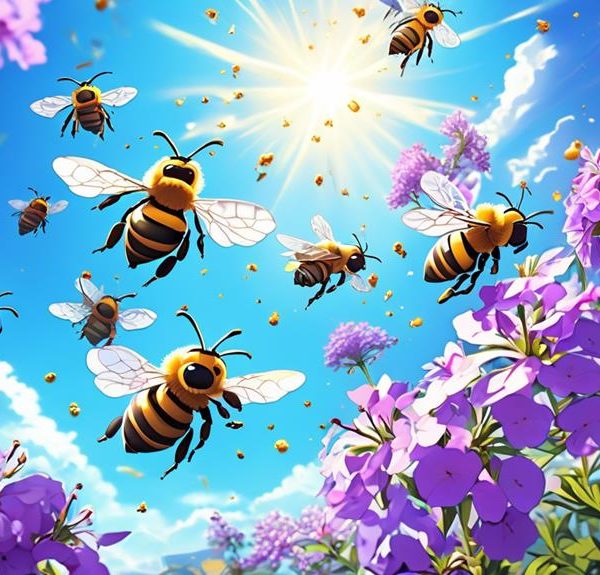Curious about why bees are drawn to milkweed? Uncover the sweet secrets behind this unique bee-plant relationship.

Do Bees Like Milkweed?
Just as you'd ponder over a menu at your favorite restaurant, bees also have their own dietary preferences when it comes to flowers. Among the smorgasbord of flora available to them, milkweed appears to play a significant role – but why exactly is that the case?
As you unravel the intricacies of this bee-plant relationship, you'll discover the hidden truths about milkweed's allure to our buzzing buddies. But let's not get ahead of ourselves – there's a whole garden of knowledge waiting to be explored.
Key Takeaways
- Bees are attracted to milkweed due to factors like its vibrant colors, sweet aroma, and high sugar concentration in the nectar.
- Milkweed's complex flower structure promotes cross-pollination and ensures a reliable food source for bees.
- Milkweed serves as a critical food source and habitat for bees, providing them with energy, protein, and shelter.
- Planting more milkweed in gardens can attract bees, enhance pollination, and support biodiversity.
Understanding Bees' Dietary Preferences

To understand bees' dietary preferences, it's crucial to delve into the specifics of their attraction to certain plants, such as milkweed. You see, bees don't just randomly visit plants. They're drawn to particular ones based on factors like color, shape, scent, and nectar content.
Milkweed, for example, has evolved complex floral structures and vibrant colors to attract pollinators like bees. It's not just about the beauty of the plant, though. The nectar of the milkweed is rich in sugars, providing bees with the energy they need to continue their foraging activities.
However, not all bees are attracted to milkweed. The plant's intricate flowers can be difficult for some bees to navigate, especially those of smaller species. On the other hand, larger bees, such as bumblebees, find it easier to access the nectar within.
The Role of Milkweed in Nature

Milkweed, often overlooked as a mere weed, plays a vital role in ecosystems by providing sustenance to diverse wildlife, including bees, and serving as the sole host plant for the brilliant monarch butterfly. It's not just a plant; it's a crucial part of a complex ecological network.
You should understand that milkweed has evolved to produce specific compounds called cardenolides. These are toxic to most species, but not to monarch butterflies. They've adapted to not only tolerate these toxins but also use them as a defense mechanism. Their larvae consume the milkweed leaves, accumulate the toxins, and become unpalatable to predators.
Moreover, milkweed nectar, rich in sugar, serves as a critical food source for bees and other pollinators. This sweet liquid nourishes worker bees, fuels their foraging flights, and helps in honey production. It's an essential part of their dietary needs.
Additionally, milkweed's complex flower structure encourages cross-pollination. When bees visit the flowers to collect nectar, they inadvertently pick up and deposit pollen, promoting genetic diversity among plants.
In essence, milkweed is a linchpin species, playing a key role in maintaining the health and balance of many ecosystems. Its value goes well beyond being a simple weed. It's a life-sustainer, a butterfly-maker, and a pollination promoter.
Milkweed: A Bee's Delight?
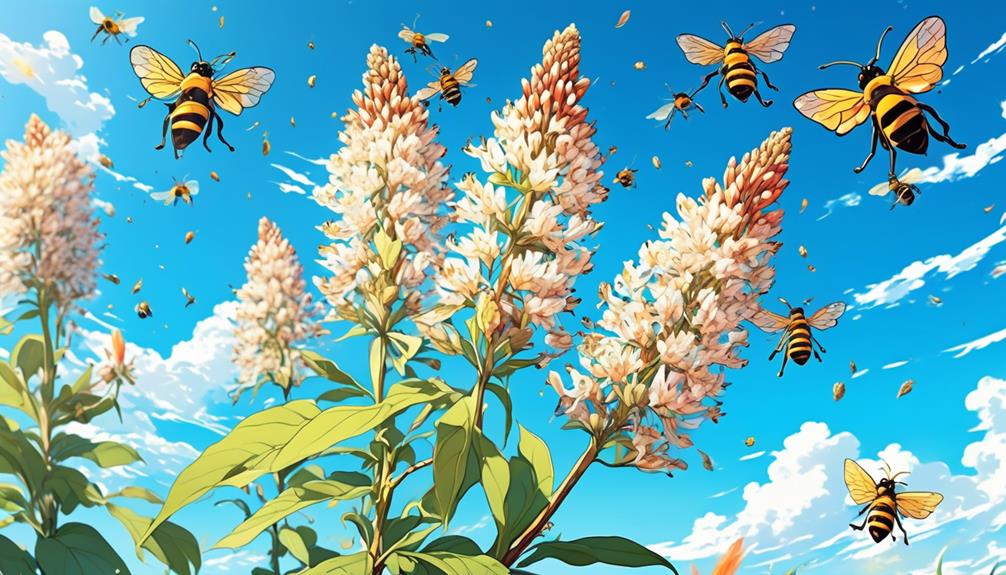
While we've established the importance of milkweed in ecosystems, you might be wondering specifically about its appeal to bees. Science tells us that milkweed indeed attracts bees, primarily due to its rich nectar content.
The milkweed plant, scientifically known as Asclepias, boasts a high nectar volume and sugar concentration. This nectar provides an energy-rich food source for a variety of pollinators, including bees. Bees are drawn to the sweet aroma and vibrant colors of milkweed flowers, and the plant's nectar serves as a powerful attractant.
In addition, milkweed's unique flower structure offers another benefit for bees. The flowers' hoods and horns, which are specialized structures designed to trap pollen, ensure that bees visiting the plant inadvertently collect and disperse pollen. This cross-pollination mechanism ensures the survival and propagation of the milkweed species, while providing bees with a reliable food source.
Scientific Research on Bees and Milkweed
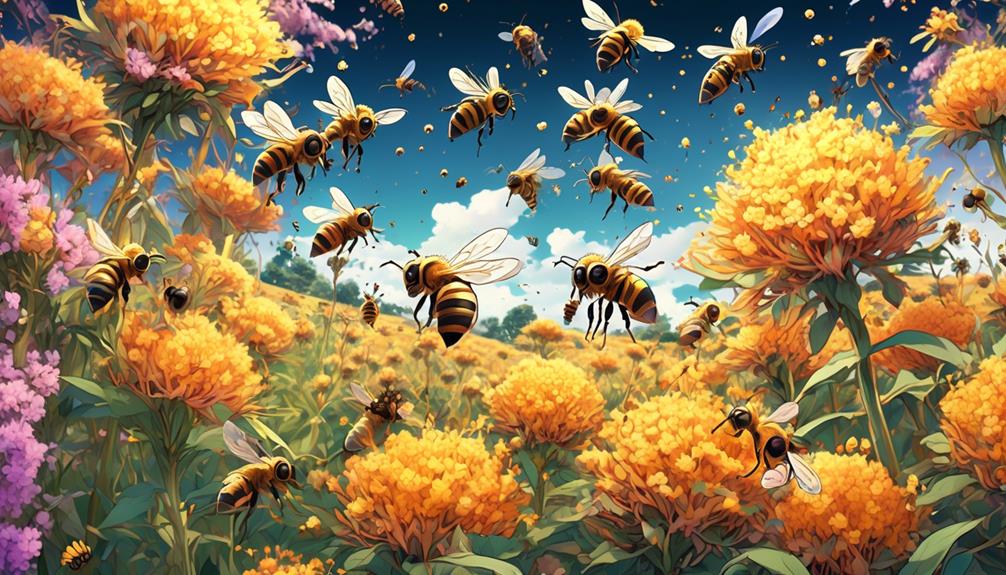
In the realm of scientific research, numerous studies have delved into the intriguing relationship between bees and milkweed, uncovering fascinating insights into their mutualistic interaction. You'll find it interesting that milkweed plants aren't just an arbitrary choice for bees; they're a strategic one.
Milkweed nectar is abundant and rich in nutrients, providing bees with a significant energy source. But there's more to it than that. The plant's complex floral structure, with its deep nectar reservoirs, promotes 'pollen-loading' onto bees. As you'd expect, this enhances pollination rates, benefiting both parties in this ecological dance.
Moreover, recent research suggests that milkweed also offers bees protection. How so? Well, the plant's latex sap contains cardiac glycosides, compounds toxic to many insects. Yet, bees appear to be immune. Instead, these compounds, when carried on the bee's body, can deter predators, giving the bee a distinct survival advantage.
How Milkweed Benefits Bee Populations
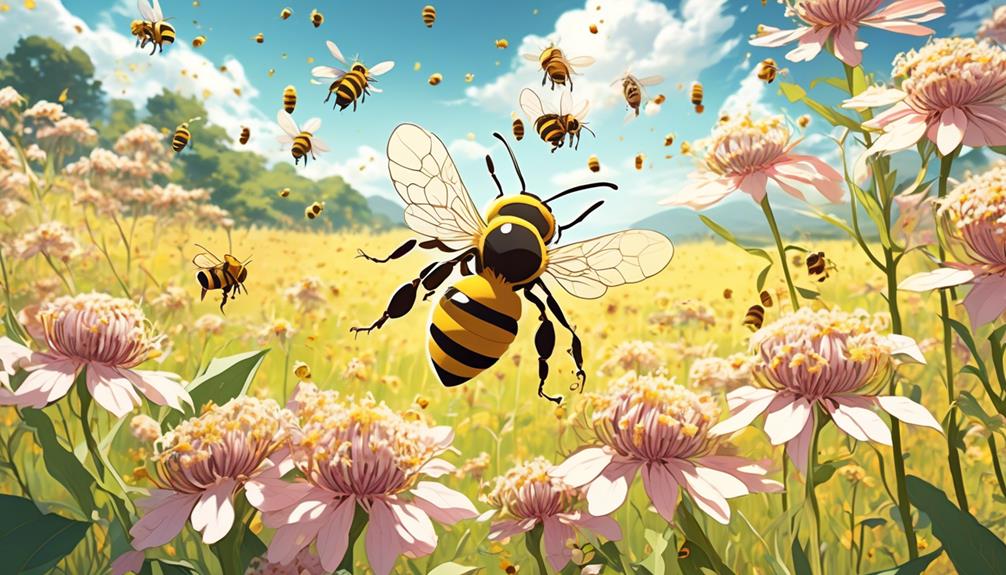
Building on this understanding of the milkweed-bee connection, let's consider more specifically how this plant bolsters bee populations.
For starters, milkweed provides a rich nectar source, which is crucial in the bees' diet. This nectar is high in both sugar and amino acids, essential for bees' energy and protein needs.
Furthermore, milkweed flowers have a unique structure that aids in pollen transfer. You see, when a bee visits a milkweed flower, its feet slip into small slits in the flower and pollen sacs adhere to the bee's legs. When the bee flies off to another milkweed plant, it carries these pollen sacs, promoting cross-pollination.
Lastly, milkweed plays a critical role in providing habitat for bees. Many native bee species nest in the ground, and milkweed's extensive root system helps prevent soil erosion, maintaining intact nesting sites.
Encouraging Bees: Planting More Milkweed
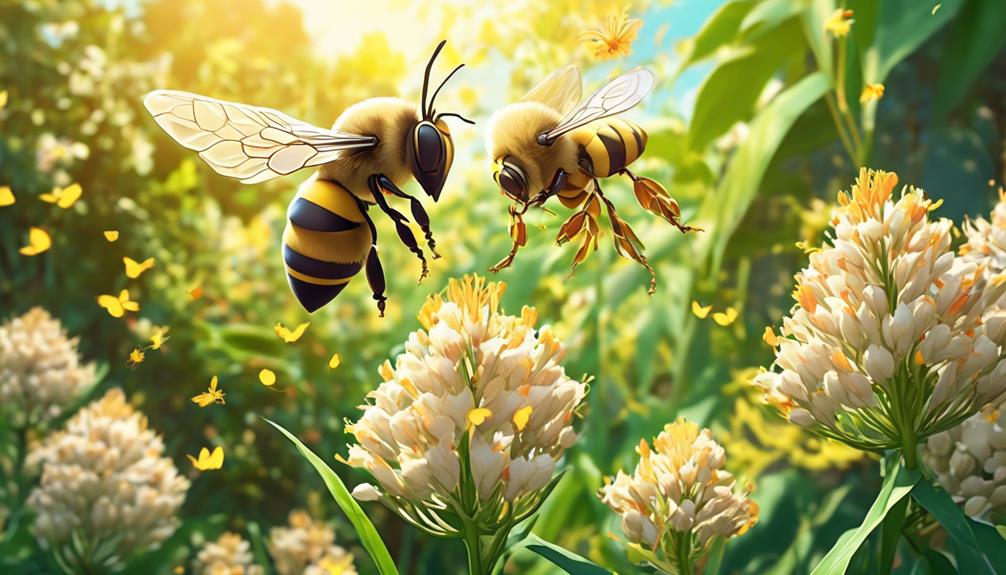
To bolster bee populations and their habitats, you should frequently consider planting more milkweed in your garden. As a plant rich in nectar, milkweed attracts bees and other pollinators. It's not just about providing food; milkweed also provides shelter for bees, enhancing their chances of survival.
Let's look at a detailed breakdown of how planting more milkweed can encourage bees:
Benefits of Milkweed | Impact on Bees |
|---|---|
Rich in Nectar | Serves as a food source for bees |
Provides Shelter | Increases survival rates |
Enhances Pollination | Ensures bee species' sustainability |
Supports Biodiversity | Creates a balanced ecosystem |
Frequently Asked Questions
Do Other Insects Also Feed on Milkweed or Is It Specific to Bees?
Yes, other insects also feed on milkweed, not just bees. Butterflies, particularly the Monarch, are famous for their relationship with milkweed. The plant provides essential nutrients for these insects.
Many beetles also munch on milkweed. So, it's not specific to bees.
In fact, milkweed's nectar and foliage are a significant food source for a variety of insects. It's a veritable insect buffet!
What Are the Potential Harmful Effects, if Any, of Bees Consuming Milkweed?
You're curious about the potential harmful effects on bees consuming milkweed. Interestingly, there's no evidence to suggest any harm. In fact, bees often benefit from milkweed's rich nectar source.
However, some pesticides used on milkweed could pose risks. It's crucial to ensure the milkweed used for bee conservation isn't treated with harmful chemicals.
In short, the plant itself isn't harmful for bees, but human interventions can cause problems.
Are There Specific Species of Bees That Are More Attracted to Milkweed?
Yes, certain bee species show a higher attraction to milkweed.
For instance, bumblebees and honeybees are often found on milkweed flowers due to their preference for the nectar. This preference isn't just about taste, but also about survival.
These bees extract nectar and pollen from milkweed, providing necessary nutrients while also aiding in the plant's pollination.
What Is the Nutritional Content of Milkweed for Bees?
You're curious about the nutritional content of milkweed for bees, aren't you?
Well, milkweed nectar is rich in sugars, specifically sucrose, that provide energy to bees.
It also contains amino acids, which are vital for bee health.
However, the exact nutritional value can vary based on the specific type of milkweed.
Is There a Specific Time of Year When Bees Are More Likely to Feed on Milkweed?
You're most likely to see bees feeding on milkweed during its blooming season, which typically falls in the summer months. During this time, the plant's nectar and pollen are at their peak, offering a rich and attractive food source for bees.
Conclusion
So, do bees like milkweed?
Absolutely, they do! Research shows that milkweed is a bee's delight, providing them with essential nutrients and aiding their survival.
Your role? Plant more milkweed! This hearty plant not only benefits our buzzing friends but also enhances biodiversity.
By encouraging a thriving bee population, you're promoting a healthier, more balanced ecosystem.
Remember, every milkweed planted is a step towards safeguarding our essential pollinators.


